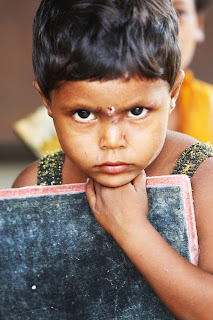Angry Child: A Glimpse into Unspoken Emotions
📸 Text
& Photo by – Ashok Karan
🔗 ashokkaran.blogspot.com
While on an
assignment deep inside a remote village near Patratu, Jharkhand, I
stumbled upon a modest, government-run school tucked away in a forgotten corner
of the countryside. Curious about the few children I saw from a distance, I
parked my car and walked in.
To my surprise,
only 10 to 12 students were packed into a tiny room, being taught by a single
lady teacher. Despite the challenges, she carried herself with quiet
dedication, guiding the children with patience and warmth.
As always, I
had my camera with me. When I lifted it to capture the moment, most of the
children lit up—some smiled, others giggled, and a few even posed with a spark
of excitement. But one little boy stood apart. He didn’t smile. He
didn’t hide. He looked straight at me—with clenched jaws and piercing, angry
eyes.
I captured the
moment, instinctively. Later, I learned from the teacher that he had just been
reprimanded for a classroom issue.
But his
expression said more than a fleeting temper. It told a deeper story—of
frustration, emotional struggle, and perhaps an environment where a child’s
feelings often go unheard.
🏡 The Context: A Life of Limitations
This school
serves a sparsely populated region where families survive on small-scale
farming, labor work, and traditional crafts. Most guardians here
come from humble backgrounds, unable to provide their children with
elite education, modern comforts, or structured emotional support.
For these
children, anger isn’t just a reaction—it’s a symptom of deeper,
often unmet emotional and psychological needs.
🧠 Why Do Children Get Angry?
Anger in
children is a natural and complex emotion, often influenced by the world
around them. Some of the key reasons include:
- Unmet needs like
hunger, fatigue, or discomfort - Lack of vocabulary to express feelings clearly
- Developmental challenges in controlling emotions
- Frustration from
tasks they can’t complete or understand - Disruptions in
routine, social conflict, or jealousy - Stressful environments or exposure to others’ anger
- A sense of powerlessness, leading to emotional eruptions
💡 Helping Children Manage Their Anger
Instead of
punishing or silencing these emotions, we must create safe, empathetic
spaces for children to express and understand them. Here are a few
supportive approaches:
- Stay calm: Respond
to anger with gentle voice and posture. Let them know, “It’s okay to
feel angry.” - Identify triggers: Understand what led to the outburst.
- Teach healthy coping: Encourage slow breathing, counting to ten, or
taking a short break. - Promote expression: Help children use words instead of actions to
explain how they feel.
🧒🏾 Emotions That Run Deep
Anger in
children is not a flaw—it’s a message. A part of growing up, of
processing the world around them. When handled with care, it can help shape resilient,
emotionally intelligent individuals.
The photo of that
angry little boy still lingers in my memory—not because of the defiance in his
eyes, but because of what it whispered:
Children often
carry burdens too big for their age, and emotions too deep for words.
📝 Text
& Photo by Ashok Karan
📍 Visit: ashokkaran.blogspot.com
📢 Please like, share, and subscribe for more grassroots stories.
📌 Hashtags:
#AngryChild
#ChildhoodEmotions #RuralIndia #AshokKaranBlogs #EveryChildMatters
#VillageSchool #EmotionalDevelopment #PhotographyWithPurpose #GrassrootsStories
#JharkhandDiaries #ChildrenAndEmotions #HumanStorytelling



Leave a Reply